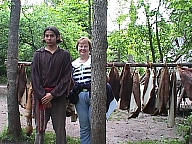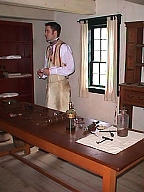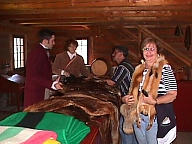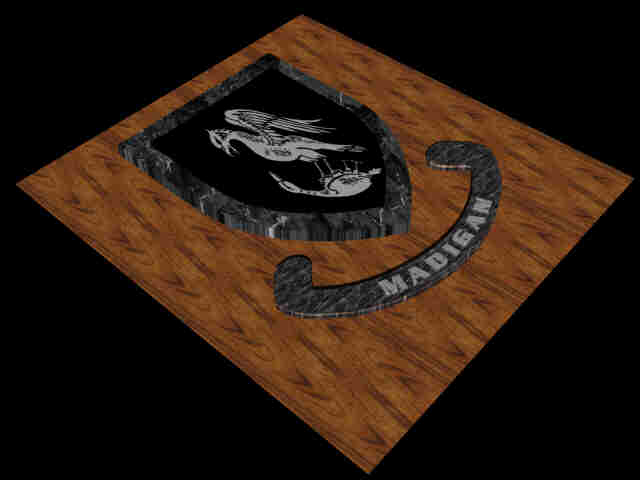From here we wandered
along the front of the palisade to the entrance. The outside
perimeter of the Fort was the home of the Voyagers. These mostly
French-Canadians worked as paddlers on the hundreds of canoes
that plied the waters both east and west carrying supplies and
fur to their respective destinations. They were broken into two
separate groups. The "Winterers" who traded with the
Indians in the west during the winter and then brought the furs
they received out of the west by canoe until they reached  Fort
William. They would then take trade goods back west to exchange
for more furs. The other group known as the "pork
eaters" were usually much bigger in size and quite
physically strong. They would pack the 90 lb. fur packs into
canoes and paddle them east to Montreal, and bring back trade
goods. There were many points at which the fur packs had to be
portaged around bad water and falls. Each man was expected to
carry a minimum of 2 packs, and many carried three. During the
great rendezvous in mid-summer, when the voyageurs from the west
and the voyagers from the east both arrived at the at the same
time, there might be several thousand people at the Fort. During
the cold winter months when there was
Fort
William. They would then take trade goods back west to exchange
for more furs. The other group known as the "pork
eaters" were usually much bigger in size and quite
physically strong. They would pack the 90 lb. fur packs into
canoes and paddle them east to Montreal, and bring back trade
goods. There were many points at which the fur packs had to be
portaged around bad water and falls. Each man was expected to
carry a minimum of 2 packs, and many carried three. During the
great rendezvous in mid-summer, when the voyageurs from the west
and the voyagers from the east both arrived at the at the same
time, there might be several thousand people at the Fort. During
the cold winter months when there was little or no activity, there might not be more
the 40 people at the fort. To feed the large gathering during the
summer months, extensive farming was conducted in and around the
Fort. Horses, cattle, sheep, chickens, a large vegetable garden
and an assortment of animal fodder were needed. This all required
buildings. Barns, houses, a great dining hall, store rooms, and a
power magazine. Carpenters, brick layers, and coopers were hired.
Then there were the clerks, accountants and stockmen responsible
for keeping track of the trade goods and getting the furs ready
for shipment east. On top of this was a small group of mostly
Scottish men who managed the entire operation for the Montreal
owners. Although located deep in the wilderness, Fort William was
not lacking for
little or no activity, there might not be more
the 40 people at the fort. To feed the large gathering during the
summer months, extensive farming was conducted in and around the
Fort. Horses, cattle, sheep, chickens, a large vegetable garden
and an assortment of animal fodder were needed. This all required
buildings. Barns, houses, a great dining hall, store rooms, and a
power magazine. Carpenters, brick layers, and coopers were hired.
Then there were the clerks, accountants and stockmen responsible
for keeping track of the trade goods and getting the furs ready
for shipment east. On top of this was a small group of mostly
Scottish men who managed the entire operation for the Montreal
owners. Although located deep in the wilderness, Fort William was
not lacking for amenities. Many types of craftsmen made their
living. plying their trade within the palisade walls. In addition
aristocratic visitors often arrived to review the business for an
extended period of time. As we rounded the corner into the fort
we came upon several buildings, each with its own actors. The
schooner Captain, the Doctor, each with a story to tell. With
accents practiced, they would enter into lively conversations
with both other actors or any of the visitors who happed to ask a
question. Always quick to act confused when anything prior to
their period was mentioned, such as computers, airplanes,
telephones, or cars, these
amenities. Many types of craftsmen made their
living. plying their trade within the palisade walls. In addition
aristocratic visitors often arrived to review the business for an
extended period of time. As we rounded the corner into the fort
we came upon several buildings, each with its own actors. The
schooner Captain, the Doctor, each with a story to tell. With
accents practiced, they would enter into lively conversations
with both other actors or any of the visitors who happed to ask a
question. Always quick to act confused when anything prior to
their period was mentioned, such as computers, airplanes,
telephones, or cars, these  docents presented a perfect image of the time
they so richly presented. As we entered the trading floor, we
were greeted with an assortment of dry goods, hardware, knives
and muskets, all arranged neatly on shelves. Each had a price, so
many plus (pronounced plew). A plus equals a credit which is paid
for by one beaver pelt, with some ability to slide the value one
way or another. Gold, silver or currency were not used in the
Fort. The basic unit of payment was one beaver skin. From the
docents presented a perfect image of the time
they so richly presented. As we entered the trading floor, we
were greeted with an assortment of dry goods, hardware, knives
and muskets, all arranged neatly on shelves. Each had a price, so
many plus (pronounced plew). A plus equals a credit which is paid
for by one beaver pelt, with some ability to slide the value one
way or another. Gold, silver or currency were not used in the
Fort. The basic unit of payment was one beaver skin. From the  trading
floor, we moved to the fur packing storehouse. Here, hanging form
the rafters and on poles throughout the entire warehouse were
pelts of every description, from beaver to arctic fox. These were
the real thing, actually captured from poachers over the years
and lent to the museum by the authorities. In the middle of the
room was a fur press. Beaver skins were compressed until a pile
of them weighed 90 lbs. They were then wrapped and tied and
became a basic fur pack which the voyagers had to carry. A young
man demonstrated the required strength as he showed how two packs
were carried using a head strap. With a mighty heave he stood
straight up under 180 lbs of beaver fur and staggered around the
room for a complete circle. The strain on his body was enormous
and evident by the protruding veins in his neck. An offer for
others in the room to try the back pack fully loaded was not
accepted by anyone.
trading
floor, we moved to the fur packing storehouse. Here, hanging form
the rafters and on poles throughout the entire warehouse were
pelts of every description, from beaver to arctic fox. These were
the real thing, actually captured from poachers over the years
and lent to the museum by the authorities. In the middle of the
room was a fur press. Beaver skins were compressed until a pile
of them weighed 90 lbs. They were then wrapped and tied and
became a basic fur pack which the voyagers had to carry. A young
man demonstrated the required strength as he showed how two packs
were carried using a head strap. With a mighty heave he stood
straight up under 180 lbs of beaver fur and staggered around the
room for a complete circle. The strain on his body was enormous
and evident by the protruding veins in his neck. An offer for
others in the room to try the back pack fully loaded was not
accepted by anyone.
 <<<<<
Back
Next >>>>>
<<<<<
Back
Next >>>>>

 Fort
William. They would then take trade goods back west to exchange
for more furs. The other group known as the "pork
eaters" were usually much bigger in size and quite
physically strong. They would pack the 90 lb. fur packs into
canoes and paddle them east to Montreal, and bring back trade
goods. There were many points at which the fur packs had to be
portaged around bad water and falls. Each man was expected to
carry a minimum of 2 packs, and many carried three. During the
great rendezvous in mid-summer, when the voyageurs from the west
and the voyagers from the east both arrived at the at the same
time, there might be several thousand people at the Fort. During
the cold winter months when there was
Fort
William. They would then take trade goods back west to exchange
for more furs. The other group known as the "pork
eaters" were usually much bigger in size and quite
physically strong. They would pack the 90 lb. fur packs into
canoes and paddle them east to Montreal, and bring back trade
goods. There were many points at which the fur packs had to be
portaged around bad water and falls. Each man was expected to
carry a minimum of 2 packs, and many carried three. During the
great rendezvous in mid-summer, when the voyageurs from the west
and the voyagers from the east both arrived at the at the same
time, there might be several thousand people at the Fort. During
the cold winter months when there was little or no activity, there might not be more
the 40 people at the fort. To feed the large gathering during the
summer months, extensive farming was conducted in and around the
Fort. Horses, cattle, sheep, chickens, a large vegetable garden
and an assortment of animal fodder were needed. This all required
buildings. Barns, houses, a great dining hall, store rooms, and a
power magazine. Carpenters, brick layers, and coopers were hired.
Then there were the clerks, accountants and stockmen responsible
for keeping track of the trade goods and getting the furs ready
for shipment east. On top of this was a small group of mostly
Scottish men who managed the entire operation for the Montreal
owners. Although located deep in the wilderness, Fort William was
not lacking for
little or no activity, there might not be more
the 40 people at the fort. To feed the large gathering during the
summer months, extensive farming was conducted in and around the
Fort. Horses, cattle, sheep, chickens, a large vegetable garden
and an assortment of animal fodder were needed. This all required
buildings. Barns, houses, a great dining hall, store rooms, and a
power magazine. Carpenters, brick layers, and coopers were hired.
Then there were the clerks, accountants and stockmen responsible
for keeping track of the trade goods and getting the furs ready
for shipment east. On top of this was a small group of mostly
Scottish men who managed the entire operation for the Montreal
owners. Although located deep in the wilderness, Fort William was
not lacking for amenities. Many types of craftsmen made their
living. plying their trade within the palisade walls. In addition
aristocratic visitors often arrived to review the business for an
extended period of time. As we rounded the corner into the fort
we came upon several buildings, each with its own actors. The
schooner Captain, the Doctor, each with a story to tell. With
accents practiced, they would enter into lively conversations
with both other actors or any of the visitors who happed to ask a
question. Always quick to act confused when anything prior to
their period was mentioned, such as computers, airplanes,
telephones, or cars, these
amenities. Many types of craftsmen made their
living. plying their trade within the palisade walls. In addition
aristocratic visitors often arrived to review the business for an
extended period of time. As we rounded the corner into the fort
we came upon several buildings, each with its own actors. The
schooner Captain, the Doctor, each with a story to tell. With
accents practiced, they would enter into lively conversations
with both other actors or any of the visitors who happed to ask a
question. Always quick to act confused when anything prior to
their period was mentioned, such as computers, airplanes,
telephones, or cars, these  docents presented a perfect image of the time
they so richly presented. As we entered the trading floor, we
were greeted with an assortment of dry goods, hardware, knives
and muskets, all arranged neatly on shelves. Each had a price, so
many plus (pronounced plew). A plus equals a credit which is paid
for by one beaver pelt, with some ability to slide the value one
way or another. Gold, silver or currency were not used in the
Fort. The basic unit of payment was one beaver skin. From the
docents presented a perfect image of the time
they so richly presented. As we entered the trading floor, we
were greeted with an assortment of dry goods, hardware, knives
and muskets, all arranged neatly on shelves. Each had a price, so
many plus (pronounced plew). A plus equals a credit which is paid
for by one beaver pelt, with some ability to slide the value one
way or another. Gold, silver or currency were not used in the
Fort. The basic unit of payment was one beaver skin. From the  trading
floor, we moved to the fur packing storehouse. Here, hanging form
the rafters and on poles throughout the entire warehouse were
pelts of every description, from beaver to arctic fox. These were
the real thing, actually captured from poachers over the years
and lent to the museum by the authorities. In the middle of the
room was a fur press. Beaver skins were compressed until a pile
of them weighed 90 lbs. They were then wrapped and tied and
became a basic fur pack which the voyagers had to carry. A young
man demonstrated the required strength as he showed how two packs
were carried using a head strap. With a mighty heave he stood
straight up under 180 lbs of beaver fur and staggered around the
room for a complete circle. The strain on his body was enormous
and evident by the protruding veins in his neck. An offer for
others in the room to try the back pack fully loaded was not
accepted by anyone.
trading
floor, we moved to the fur packing storehouse. Here, hanging form
the rafters and on poles throughout the entire warehouse were
pelts of every description, from beaver to arctic fox. These were
the real thing, actually captured from poachers over the years
and lent to the museum by the authorities. In the middle of the
room was a fur press. Beaver skins were compressed until a pile
of them weighed 90 lbs. They were then wrapped and tied and
became a basic fur pack which the voyagers had to carry. A young
man demonstrated the required strength as he showed how two packs
were carried using a head strap. With a mighty heave he stood
straight up under 180 lbs of beaver fur and staggered around the
room for a complete circle. The strain on his body was enormous
and evident by the protruding veins in his neck. An offer for
others in the room to try the back pack fully loaded was not
accepted by anyone. 